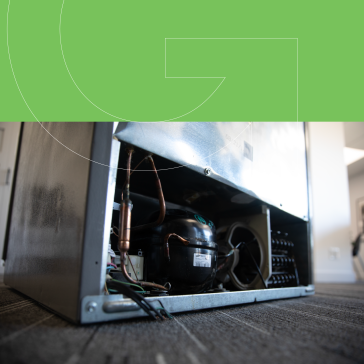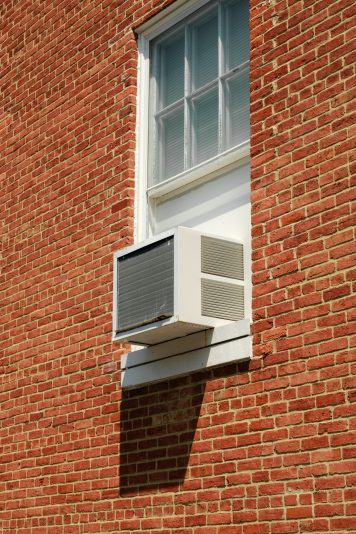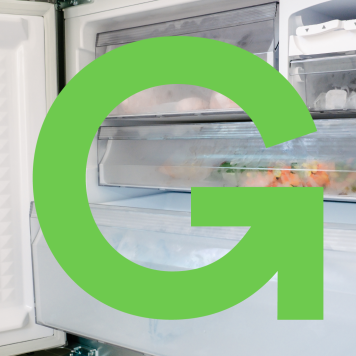In addition to regularly cleaning the inside of your fridge, did you know that you must maintain your fridge yearly in order to maximize its life span? Spring cleaning is a great time to take care of your fridge and ensure that it lasts longer.
Practical maintenance guide for a lasting fridge
Articles |
What is the life expectancy of a fridge?
The life span of a refrigerator varies depending on the brand, model, and maintenance. However, with regular maintenance, you can make sure your appliance lasts for a very long time.
Why is regular fridge maintenance so important?
Whether you have a small, compact or counter-depth refrigerator, proper maintenance is key to:
- Keep it running smoothly.
- Save energy (and money!).
- Extend its service life.
- Preserve your health by eliminating breeding grounds for bacteria and cross-contamination risks that can jeopardize sanitary food quality.
- Avoid unnecessary fridge repair costs for parts or labour.
- Avoid having to replace your fridge before it’s due.
Steps for maintaining your fridge
How can you maintain your used fridge to extend its service life? Here are a few steps to follow.
Step 1: Unplug your fridge
Before doing any kind of maintenance on your fridge, you must first unplug it from all power sources to avoid accidents.
Step 2: Clean the inside of your fridge
To preserve food quality and avoid contamination, the inside of your fridge must be cleaned every month. Here’s how to do it:
- Remove all food from the fridge and store it in a cool place while you clean your appliance (e.g.: in a cooler with ice). Take advantage of this opportunity to sort and dispose of any expired food.
- Remove all shelves and drawers.
- Soak the shelves and drawers in soapy water (using dish soap) in the kitchen sink, if possible. Otherwise, wash by hand using a sponge filled with dish soap.
- While they soak, clean the inside of your fridge using warm soapy water (dish soap) and a sponge, then dry thoroughly. Be sure to use warm water, since hot water can damage glass or plastic parts.
- Scrub shelves and drawers once they have soaked in the soapy water, then rinse well and dry.
- Put the shelves and drawers back in place.
- Using a wet rag, wipe down the seal inside the fridge door to remove built-up dirt, which can prevent it from sealing properly.
Step 3: Clean the outside of the fridge and the coils
Now that the inside of your fridge is sparkling clean, it’s time to tackle the outside. Here are the steps to follow:
- Wipe down the doors, handles, fridge top and sides using a damp sponge with a few drops of dish soap to remove all dust and dirt buildup.
- Carefully pull your fridge out to safely reach behind it.
- Gently clean the condensation coils (black grate) behind the fridge by removing dust or dirt buildup using a damp cloth or sponge. Accumulated dirt can damage the compressor, which can force the appliance to use more energy to maintain an optimal temperature, while potentially reducing its life span and increasing energy costs
- Sweep under and around your fridge to remove dust buildup
- Be sure to dry out all washed parts completely before plugging your fridge back in. Only put your food items back in once the appropriate temperature has been reached.
Always follow the steps in your appliance’s instruction manual. Instructions may vary depending on your fridge model and the year of manufacture.
5 best practices to extend the life of your fridge
You already take good care of your fridge, but did you know that there are in fact several best practices for extending its life?
Here’s a list of tips to incorporate into your daily routine:
- Set your fridge to the ideal temperature by keeping it at 4 °C, and your freezer at ‑18 °C, according to Health Canada.
- Let your food cool before storing it in the fridge (link in French only) – this prevents the compressor from having to bring your food up to temperature.
- Defrost your freezer frequently to avoid frost buildup, which reduces the efficiency of your appliance.
- Choose an ENERGY STAR®-certified medium-capacity refrigerator that is 9% to 10% more energy efficient than the Canadian standard.
- Organize your food (link in French only) to allow for optimal air circulation:
- Don’t overload shelves. Leave enough space between foods to allow cold air to circulate evenly.
- Store fruits and vegetables at the bottom of the fridge in the bins, taking care to separate fruit from vegetables (link in French only).
- Follow the best practices for organizing food by fridge zones (link in French only).
Fridge problems
If your refrigerator is no longer cooling or is cooling less than before, there could be a refrigerant gas leak in your cooling system. We recommend contacting a refrigerator repair service without delay, consult the Elexpertise repairers list.
Refrigerant gases are greenhouse gases (GHG) that are harmful to the environment and are 140 to 11,700 times more powerful than CO2.
A fridge should always be repaired before being replaced with a new one. This helps avoid using the raw materials required for the production of a new appliance.
Environmental impact of a fridge that is not recycled
Has your old fridge given out, despite taking good care of it? Before you leave it on the side of the road, did you know that recycling your refrigerator is equivalent to using a reusable coffee mug 13,870 times?
“[…] a cooling appliance generates an average of one ton of GHG! If the appliance is not recycled properly, then the gases and hazardous materials it contains are not disposed of correctly… and subsequently released into the environment. Halocarbons are greenhouse gases with substantial environmental impacts that contribute to climate change.” — GoRecycle
How to recycle your old fridge
When you entrust your fridge to one of GoRecycle’s 368 drop-off points throughout Quebec, 95% of its materials are recovered.
A number of retailers also offer a free removal service when you purchase a new fridge. Some Quebec municipalities also offer a fridge home removal service; a tangible gesture to help protect the environment.
So keep up the maintenance for a fridge that will run smoothly for years to come!
About GoRecycle
GoRecycle is the only organization recognized by RECYC-QUÉBEC that ensures the responsible recycling of cooling appliances in Quebec. We recycle refrigerators, air conditioners, freezers, wine coolers, dehumidifiers and water coolers through nearly 400 drop-off points in Quebec, and over 100 banner pickup partners with the purchase of a new fridge. GoRecycle is a non-profit organization (NPO).






